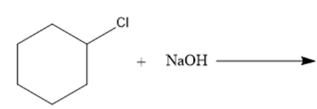
(a)
Interpretation: The nucleophile, leaving group and product formed needs to be identify for the given substitution reaction.

Concept Introduction: In a nucleophilic substitution reaction, the electron rich nucleophile attacks on the electrophilic center of an electrophile (electron deficient) to form nucleophile substituted product. Here, nucleophile can be neutral or have a negative charge. The substitution of nucleophile on the electrophile causes leaving group to leave the electrophile.
(b)
Interpretation: The nucleophile, leaving group and product formed needs to be identify for the given substitution reaction.

Concept Introduction: In a nucleophilic substitution reaction, the electron rich nucleophile attacks on the electrophilic center of an electrophile (electron deficient) to form nucleophile substituted product. Here, nucleophile can be neutral or have a negative charge. The substitution of nucleophile on the electrophile causes leaving group to leave the electrophile.
(c)
Interpretation: The nucleophile, leaving group and product formed needs to be identify for the given substitution reaction.

Concept Introduction: In a nucleophilic substitution reaction, the electron rich nucleophile attacks on the electrophilic center of an electrophile (electron deficient) to form nucleophile substituted product. Here, nucleophile can be neutral or have a negative charge. The substitution of nucleophile on the electrophile causes leaving group to leave the electrophile.
(d)
Interpretation: The nucleophile, leaving group and product formed needs to be identify for the given substitution reaction.

Concept Introduction: In a nucleophilic substitution reaction, the electron rich nucleophile attacks on the electrophilic center of an electrophile (electron deficient) to form nucleophile substituted product. Here, nucleophile can be neutral or have a negative charge. The substitution of nucleophile on the electrophile causes leaving group to leave the electrophile.
Want to see the full answer?
Check out a sample textbook solution
Chapter 7 Solutions
Organic Chemistry (6th Edition)
- Determining the Substitution and Elimination Products from an Alkyl Halide Draw the products of the following reaction.arrow_forwardDraw the products and identify the type of reaction. What functional groups is in the starting material and which functional groups are in the final product.arrow_forwardDraw the products of each reaction, and label the nucleophile and electrophile. (see the attachment)arrow_forward
- Draw the product for the following reaction between an alkyne and one equivalent of HClarrow_forwardDetermining the Mechanism of Nucleophilic Substitution Determine the mechanism of nucleophilic substitution for each reaction and draw the products.arrow_forwardDraw the carbocation intermediate of the reaction and arrows showing the resonance.arrow_forward
- For the following reaction, use the identity of the alkyl halide and nucleophile to determine which substitution mechanism occurs. Then determine which solvent affords the faster reaction.arrow_forwardIdentify the nucleophile and electrophile on the reactant side of each of these reactionsarrow_forwardDraw the product for the following alkene addition (hydrogenation) reaction.arrow_forward
- Draw the structure for the nucleophilic substitution product.arrow_forwardIdentify the electrophile and the nucleophile in each of the following reaction steps. Then draw curved arrows to illustrate the bond-making and bond-breaking processes.arrow_forwardDraw the major 1,2-addition product and the major 1,4-addition product of the following reaction. Which product is formed at a high temperature? Which product is the thermodynamic product?arrow_forward
 ChemistryChemistryISBN:9781305957404Author:Steven S. Zumdahl, Susan A. Zumdahl, Donald J. DeCostePublisher:Cengage Learning
ChemistryChemistryISBN:9781305957404Author:Steven S. Zumdahl, Susan A. Zumdahl, Donald J. DeCostePublisher:Cengage Learning ChemistryChemistryISBN:9781259911156Author:Raymond Chang Dr., Jason Overby ProfessorPublisher:McGraw-Hill Education
ChemistryChemistryISBN:9781259911156Author:Raymond Chang Dr., Jason Overby ProfessorPublisher:McGraw-Hill Education Principles of Instrumental AnalysisChemistryISBN:9781305577213Author:Douglas A. Skoog, F. James Holler, Stanley R. CrouchPublisher:Cengage Learning
Principles of Instrumental AnalysisChemistryISBN:9781305577213Author:Douglas A. Skoog, F. James Holler, Stanley R. CrouchPublisher:Cengage Learning Organic ChemistryChemistryISBN:9780078021558Author:Janice Gorzynski Smith Dr.Publisher:McGraw-Hill Education
Organic ChemistryChemistryISBN:9780078021558Author:Janice Gorzynski Smith Dr.Publisher:McGraw-Hill Education Chemistry: Principles and ReactionsChemistryISBN:9781305079373Author:William L. Masterton, Cecile N. HurleyPublisher:Cengage Learning
Chemistry: Principles and ReactionsChemistryISBN:9781305079373Author:William L. Masterton, Cecile N. HurleyPublisher:Cengage Learning Elementary Principles of Chemical Processes, Bind...ChemistryISBN:9781118431221Author:Richard M. Felder, Ronald W. Rousseau, Lisa G. BullardPublisher:WILEY
Elementary Principles of Chemical Processes, Bind...ChemistryISBN:9781118431221Author:Richard M. Felder, Ronald W. Rousseau, Lisa G. BullardPublisher:WILEY





